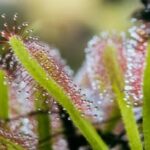As an Amazon Associate, this site earns commissions from qualifying purchases. For more details, click here.
Misting is good for houseplants in general, but what about a carnivorous plant like a drosera? Will it benefit from the occasional misting, or is heavy misting required? Or are your sundews better off without any of this? There is a lot of confusion over this topic and this article is going to clear everything up.
Sundews need a lot of water, but misting is not necessary and it could even be harmful. The reason you should not mist sundews is too much water dilutes the dew, which the plant uses to trap insects.
Why Misting Sundews is Not Needed
Misting or lightly spraying water on plants is a common practice. In fact that is how most people water houseplants. But sundews are not your typical plant and they will not benefit from it.
Misting sundews regularly could slow down its ability to generate mucilage or dew. This is the sticky substance on the tentacles of the plant.
If your sundew is sitting in water, there is no need to do any misting. The plant is receiving enough water to meet its needs.
The consistency of mucilage is somewhat like mucus or glue, but nowhere near as binding. It is the sticky part that allows the plant to trap insects.
If you mist the tentacles, the water could dilute or wash away the mucilage entirely. And without it your sundew will not be able to catch any prey.
Sundews produce mucilage to entice insects. Ants, mosquitoes, flies and other bugs are rich in nitrogen which sundews need. These elements are found in rich soil, but these plants only grow in nutrition free dirt so they have to get these through other means.
Mucilage produces a scent that insects – and even worms and frogs – are drawn to. If a mosquito tries to eat it, it gets stuck. The sundew trap works similarly to flypaper except as the insect struggles to get out, the other tentacles swoop in to entrap it.
So here it is clear why sundews need mucilage or dew. Without it there is no way the plant can obtain the nutrients it needs. While sundews need water, too much will affect its dew production or even halt it completely.
Drosera also needs dew to eat non-living food. Sundews can eat Picky Neb Dried Mealworms only if there is dew. If there is none, the plant will not be able to absorb it. This is true of any food you try and feed it. Without dew, sundews cannot eat.
Mucilage production is a complex process, and sundews cannot afford to waste them. So if your sundew is doing fine there is no need to do any misting.
Will Misting Kill My Sundews?
You have probably read online or even spoke with some people who mist their sundews. And they will tell you their plants are fine. There are a few instances where sundews might tolerate misting, but most of the time it is not necessary.
Misting a few times will not kill sundews. But if you mist every day the leaves will get soaked in water and wash out its dew. This forces the plant to produce more dew which requires a lot of energy.
Sundews that grow in the wild and even those at home that are left outside are exposed to light drizzles. It does not harm their dew production because it does not happen every day.
So what happens is your sundew is forced to generate more mucilage while not being able to absorb any nutrients. Sundews can live for a long time, but only with nutrients. Otherwise the plant will weaken and be vulnerable to disease.
The only times misting sundew is acceptable:
- Your sundew is not sitting in water. In this case you need to water it everyday and misting is fine.
- Misting during hot, dry days.
- The leaves are drying out.
Another thing to keep in mind is the effects of misting does not appear right away. So if you just started spraying the plant a few days ago, everything will look fine. But after a few weeks the leaves start to look drab.
Some sundew variants are more sensitive to misting than others. The drosera binata, drosera natalensis and most tuberous sundews lose their dew and luster if you mist them regularly.
Because there are so many sundew species, your plant might tolerate this more than others. If you want, you can experiment and see how the plant reacts. Usually any ill effects manifest in two weeks or so.
What is the Best Alternative to Misting?
Sundews require plenty of water so there is tendency for some to overdo it. And misting even lightly, can cause overwatering if the plant is already sitting in water.
The best alternative to sundew misting is no misting. Use the tray method to water the plant and that should be enough.
If you have never used the tray method before, it is very simple.
- Plant your sundew in a container if you have not already done so.
- Get a tray that is at least a few inches deep.
- Put the container inside the tray.
- Add water to the tray. For a 10 inch deep container, one or two inches of water is fine. Use only purified or distilled water like the RPI 4L Distilled.
That is all you need to do. The roots will absorb the water so refill before the tray dries out. If humidity is low when growing seeds, cover the tray with a plastic wrapper to trap the moisture. Sundew seeds need humidity so a plastic will prevent it from escaping.
Unless it is very dry in your area, the tray method should be enough for your sundew. Every month or so, remove the container and let the tray dry. This is necessary to prevent fungi from settling in the stagnant water. Dry the tray and then put the sundew back in.
It is all right to water from the top every month or so to remove any debris in the soil. If your sundew is indoors and you feed it, some food bits might end up in the soil.
Watering from the top will remove these foods, which is necessary to keep the soil free from nutrients. Sundews will not grow in rich soil and if those food bits enrich the ground, could harm the plant.
What Else Should I Know about Misting Sundews?
If you go online or just talk to other sundew owners, you will get all sorts of responses and opinions about misting. It is easy to get confused so let us keep things simple.
- Misting will not kill sundews. But if you do it every day it could wash away the dew or mucilage. You will see the effects in two weeks or less.
- Misting is not going to help sundews grow faster. If your sundew is not producing dew, it needs more sunlight.
- The tray method is the most effective way to water sundews.
- Misting does not stimulate growth. On the contrary, too much water is bad for sundews. Yes these plants can be overwatered.
There are many types of sundews so some might take misting better than others, especially during summer. You can try misting for a week or two and see what happens. If you are going to do this, use only rain water or distilled water. Do not expect to see any improvement in growth. In fact the only purpose of this experiment is to see if misting slows or stops mucilage production.
Sundews can handle temperatures up to 100 F / 37.7 C. If it gets hotter than that, bring the plant indoors or move it under shade. If the plant is already inside, add more water to the tray as necessary. Under thee conditions the roots will soak up the water faster.
Sundews will also tolerate light misting under these conditions. You do not have to worry about overwatering at this point. Under normal weather conditions however your sundew will be fine just sitting in water.
Conclusion
Misting sundews is not going to kill the plant, but it is mostly unnecessary. And as explained here, it might actually slow down dew production. While there are cases where misting might help, it should really be avoided most of the time.

My fascination with carnivorous plants began many, many years ago with Venus Fly Traps. Now I am more than happy to impart what I know with other enthusiasts and those who are curious about meat eating plants.



